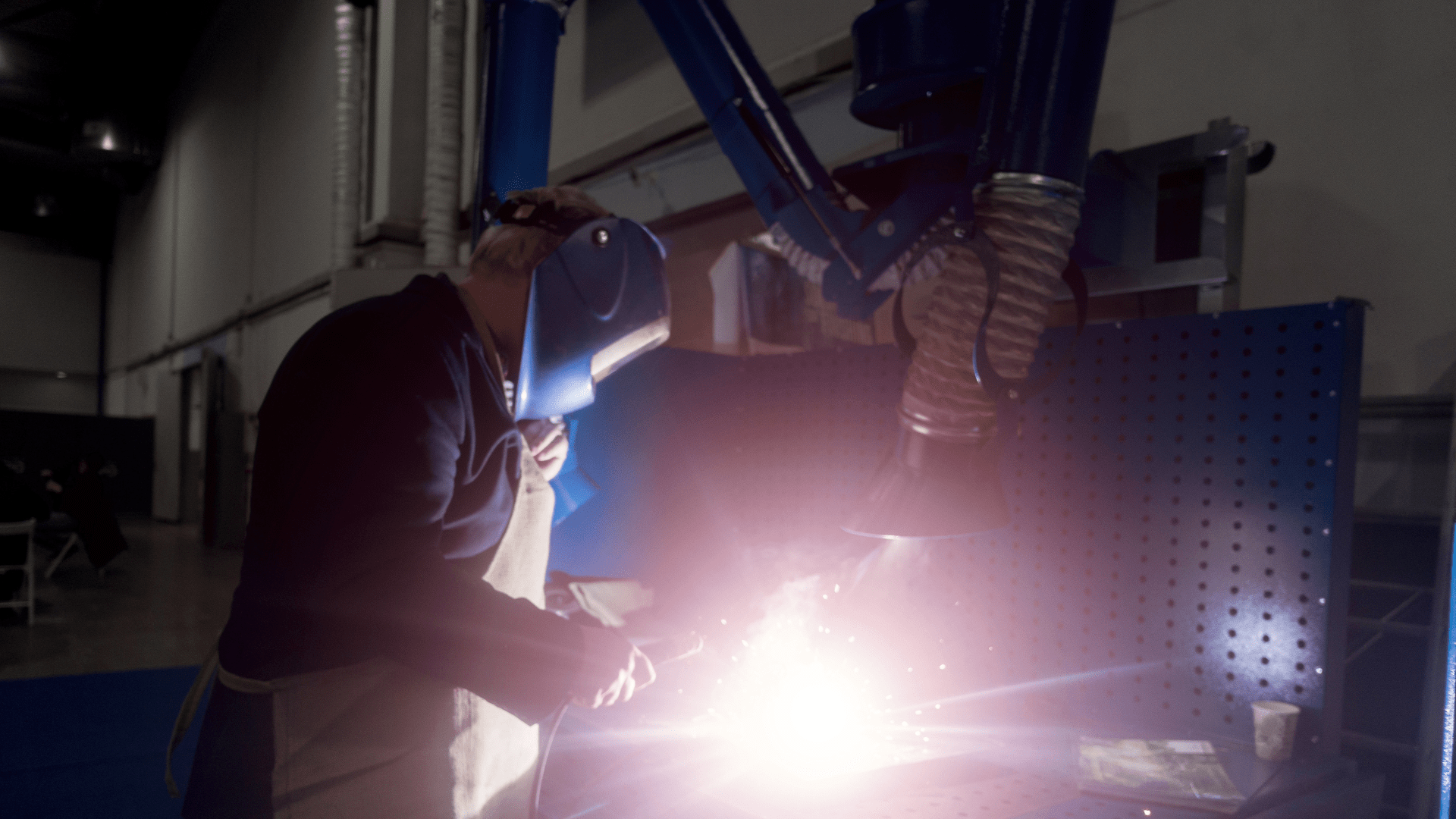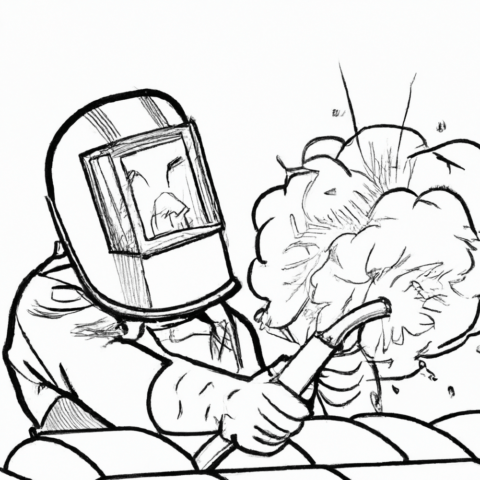Welding fumes are a mixture of metallic oxides, silicates, and fluorides. These fumes are formed when the welding flame vaporizes the metal and filler material. Exposure to these fumes can pose significant health risks to welders, ranging from short-term respiratory irritation to long-term risks such as lung cancer and neurological damage. Understanding these hazards is the first step towards ensuring the safety and health of workers in the welding industry.
Welding fumes are a complex mixture of metallic particles that are formed when a metal or metals are heated above their boiling point. The high temperatures cause the metals to vaporize, and the vapors then condense into fine, airborne particles that form the welding fumes.
The exact composition of welding fumes depends on the materials being welded and the process used. Common elements in welding fumes can include iron, manganese, chromium, nickel, zinc, copper, and lead. Additionally, gases such as argon, helium, carbon dioxide, nitrogen, and ozone can be present, depending on the welding process.
Several factors can influence the generation of welding fumes. These include the type of welding process used (e.g., stick welding, MIG, TIG), the composition of the base metal and filler material, the temperature of the welding process, the presence of coatings or contaminants on the workpiece (such as paint, rust, or oil), and the use of any shielding gases. Understanding these factors can help in developing strategies to reduce fume generation and exposure.
In this guide:
Huge Savings on Fume Extraction!
Check out our fantastic range of fume extractors from top brands including Kemper, Nederman, and Weldability SIF

Hazards of Welding Fumes
Immediate Physical Effects of Exposure to Welding Fumes
Exposure to welding fumes can cause immediate physical effects, including irritation of the eyes, nose, and throat, coughing, shortness of breath, and nausea. In some cases, high concentrations of certain types of fumes can lead to a condition known as metal fume fever, which is characterized by flu-like symptoms such as fever, chills, and muscle aches.
Different types of welding fumes pose different hazards. For example, fumes containing chromium VI compounds, which are often produced during stainless steel welding, are highly toxic and carcinogenic. Similarly, welding processes that generate fumes containing nickel can increase the risk of lung and nasal cancer. Understanding these specific hazards is crucial for implementing effective safety measures.
Long-term Health Risks Associated with Welding Fumes
Research in the field has consistently shown that exposure to welding fumes can lead to a range of health issues. These include immediate physical effects such as eye, nose, and throat irritation, as well as more serious long-term conditions:
- Respiratory Issues: Chronic exposure to welding fumes can lead to serious respiratory conditions. These include occupational asthma, chronic obstructive pulmonary disease (COPD), lung fibrosis, and pneumoconiosis – a group of lung diseases caused by inhalation of certain types of dust particles.
- Neurological Effects: Certain metals present in welding fumes, such as manganese, can have neurotoxic effects. Long-term exposure can lead to manganism, a Parkinson’s-like condition characterized by tremors, stiffness, and balance problems.
- Cancer Risks: Welding fumes have been classified as Group 1 carcinogens by the International Agency for Research on Cancer (IARC). This means they are carcinogenic to humans, with prolonged exposure linked to an increased risk of lung cancer and possibly larynx and urinary tract cancers.
Case studies from various industrial settings have highlighted the impact of welding fumes on workers’ health. These real-world examples underscore the research findings, showing workers developing respiratory and neurological symptoms after prolonged exposure to welding fumes. In many cases, these health issues were found to be directly related to inadequate safety measures, such as poor ventilation and lack of personal protective equipment. These case studies emphasize the need for stringent safety measures in workplaces where welding is a common activity.
Mitigation Strategies and Safety Measures
Ventilation and Fume Extraction Systems
Proper ventilation is a crucial factor in mitigating the risks associated with welding fumes. This includes both general ventilation to maintain good air quality in the workspace and local exhaust ventilation systems that capture and remove fumes at the source. Fume extraction systems, which can be integrated into the welding equipment or set up separately, are particularly effective at reducing welders’ exposure to harmful fumes.
Personal Protective Equipment (PPE) for Welders
Personal protective equipment is another essential component of safety measures for welders. This includes respiratory protective equipment such as welding fume respirators or masks, which can filter out the harmful particles present in welding fumes. Other important PPE includes safety glasses, welding helmets, and protective clothing to protect against burns and radiation.
Best Practices for Minimizing Exposure to Welding Fumes
In addition to proper ventilation and PPE, there are several best practices that can help minimize exposure to welding fumes. These include:
- Training: Welders should be trained on the risks associated with welding fumes and the correct use of PPE and ventilation systems.
- Regular Maintenance: Ventilation and fume extraction systems should be regularly maintained to ensure they are working effectively.
- Safe Work Practices: Whenever possible, welders should position themselves to avoid breathing in welding fumes. They should also take regular breaks to limit their exposure.
Legal and Industry Standards for Welding Fume Exposure
- United Kingdom: In the UK, the Health and Safety Executive (HSE) regulates exposure to welding fumes. The HSE has recently strengthened its enforcement expectations for mild steel welding fume due to the reclassification of mild steel welding fume as a human carcinogen. The HSE requires suitable exposure control measures for all welding activities, indoors and outdoors.
- United States: In the US, the Occupational Safety and Health Administration (OSHA) sets and enforces standards for exposure to welding fumes. OSHA has established permissible exposure limits (PELs) for various components of welding fumes, such as manganese, nickel, and chromium. Employers are required to implement engineering controls, work practices, and provide personal protective equipment to keep exposure at or below these limits.
- European Union: In the EU, the European Agency for Safety and Health at Work (EU-OSHA) provides guidelines for managing risks associated with welding, including exposure to welding fumes. The EU also has directives in place that set out minimum requirements for the protection of workers from risks related to exposure to carcinogens or mutagens at work, which would include certain components of welding fumes.
These standards and regulations are crucial for ensuring the safety and health of welders. Compliance with these standards is not just a legal obligation, but also a key component of maintaining a safe and healthy working environment.
Innovations in Welding Safety
Technological Advancements in Fume Extraction Systems
As our understanding of the hazards of welding fumes has grown, so too has the technology designed to mitigate these risks. Modern fume extraction systems are becoming increasingly efficient and user-friendly. Some systems now feature automatic start-stop functionality, which activates the system only when welding is taking place, saving energy and reducing noise. Others have advanced filtration systems that can capture even the smallest particles, improving air quality and reducing the risk of respiratory issues.
Innovations in Personal Protective Equipment (PPE) for Welders
In the realm of PPE, innovations are making safety equipment more comfortable and effective. For example, some welding helmets now come with built-in air filtration systems that provide a constant supply of filtered air, offering protection against fumes while also keeping the wearer cool. Other advancements include heat-resistant materials that are lighter and more durable, making protective clothing more comfortable to wear for extended periods.
Future Trends in Welding Safety
Looking to the future, we can expect to see further advancements in welding safety. This could include the development of smarter fume extraction systems that can adapt to different welding processes and environments, or the use of wearable technology to monitor welders’ exposure to fumes in real-time. As technology continues to advance, the goal remains the same: to protect the health and safety of welders, and to create a working environment that is as free from hazards as possible.
Welding, while a critical process in numerous industries, presents significant health risks due to the fumes it produces. These fumes, composed of various metallic particles, can cause both immediate and long-term health effects, including respiratory diseases, neurological conditions, and cancer. The importance of understanding these hazards cannot be overstated, as it forms the basis for implementing effective safety measures.
While significant strides have been made in improving the safety of welding operations, there is always room for improvement. Continued research into the health effects of welding fumes is needed to further refine safety standards and exposure limits. At the same time, innovation in safety equipment and practices is crucial for providing welders with the best possible protection. By maintaining a focus on safety, we can ensure that welding continues to be a viable and valuable process in our industries, without compromising the health and well-being of the workers who make it possible.




